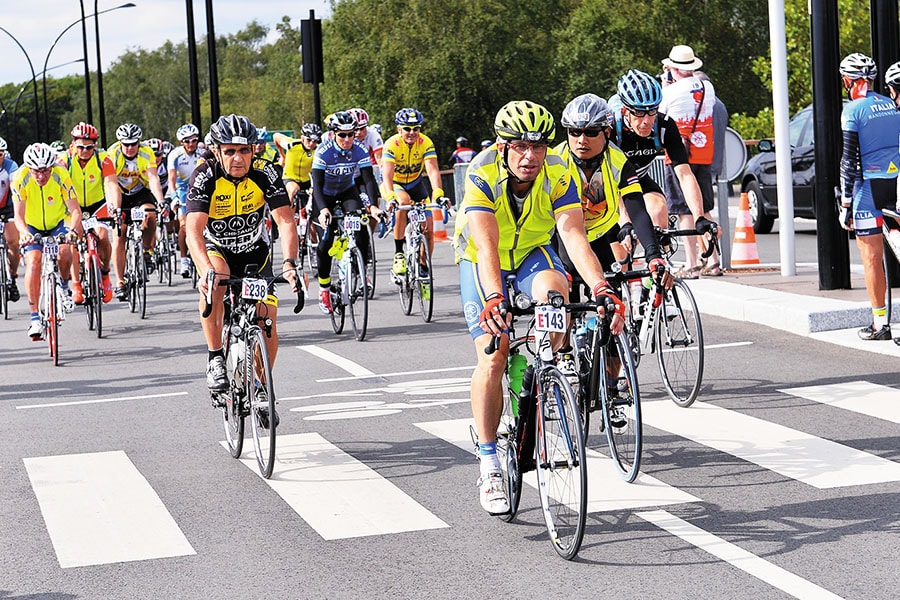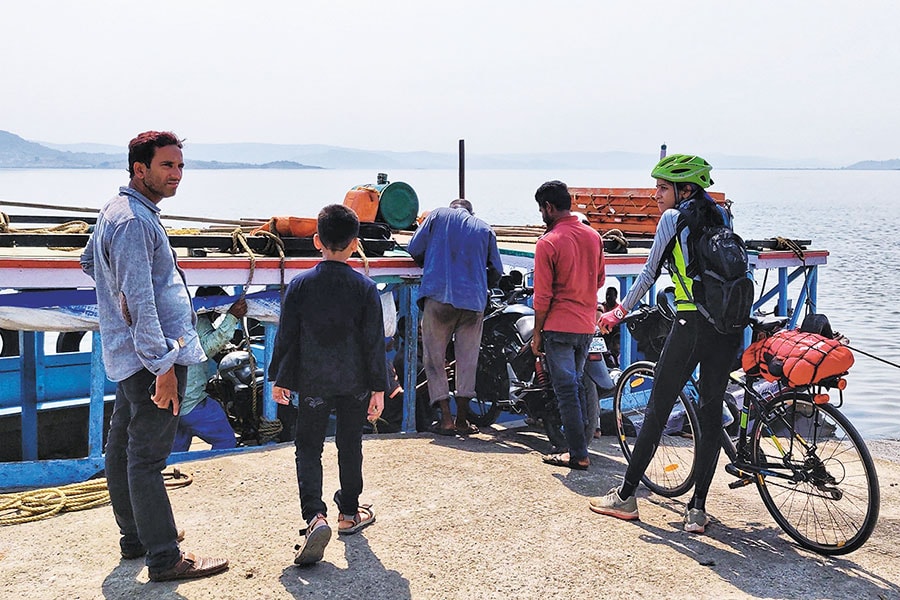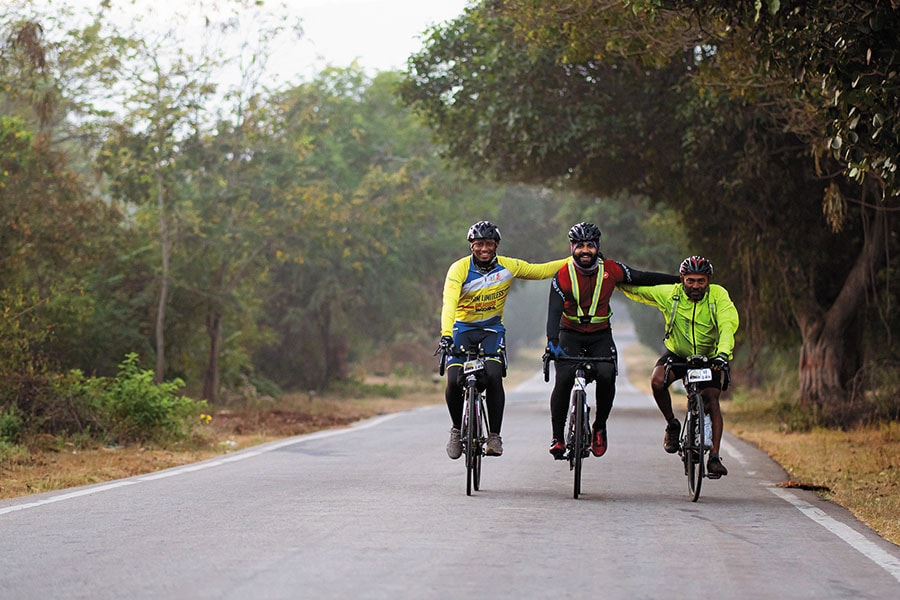Distance cycling: How to take on the long haul
For self-supported long-distance cyclists, it is more about winning over their body and mind rather than the race


.jpg) Anurag Dagar won in the Mavericks category at the La La Land Ultra, a self-supported race
Anurag Dagar won in the Mavericks category at the La La Land Ultra, a self-supported race
Image: Irregulars
While growing up in Alibag, near Mumbai, one of the earliest adventures that Sumit Patil undertook was a seven-day cycling trip with a few friends from school. All that they carried with them was a bag with a few essentials and spare parts for their bicycles.
Over time, the distances grew longer for Patil, as the bicycle became a means to explore different parts of the country. The minimal gear was strapped on to his ride, and while he had a general idea about the route, there was no planned itinerary. The idea was to soak in the adventures that the open road offered and cherish the generosity of the people he met en route.
Last July, Patil lined up alongside five other cyclists in Manali, Himachal Pradesh. And while the idea remained the same—the riders carried supplies on their bicycles to take on the 650-odd kilometres to Turtuk in Ladakh—this time there was a time constraint to be dealt with: Patil was riding his first self-supported race called the La La Land Ultra.
Although the humble bicycle has been around as a mode of transport for a couple of centuries, in the course of time it became a means of travelling over long distances. In India, long-distance cycling grew in popularity when randonneuring arrived around a decade ago. Cycling groups in various pockets of the country negotiated hundreds of kilometres as part of brevets, supporting each other on the route while sourcing supplies such as food and water along the way. The ultimate aim for most was a sense of achievement and the joy of finishing the ride.
“The format is to be self-sufficient and take care of yourself on the ride. At the same time, it doesn’t require much fitness, so it’s accessible to a lot of people of different ages. It’s been a huge part of the growth of long-distance cycling,” says Divya Tate, who founded Audax India Randonneurs and started overseeing randonneuring in India in 2011.
Supported cycling races include crew vehicles that move with each of the participants, and supply everything from nutrition and hydration, change of clothes, a place to rest during a break and in some cases, even an onboard mechanic. While there is comfort for the cyclist knowing there’s back-up on hand, it also considerably raises the cost of racing, making it inaccessible for a few.
On the other hand, self-supported races are those in which participants are by themselves, without the help of any crew. Some participants carry enough supplies to last them a day or two, choosing to restock along the way or, as in some races, pick up supplies they have left beforehand at designated spots. Bicycle spares are packed onboard, though major mechanical failures mean a premature end to the race.
Cyclists at the the Paris-Brest-Paris race
Mustafa Yalcin / Anadolu Agency / Getty Images
One of the oldest randonneuring events—it started off as a race, which was soon discontinued—in the world, the 1,200-km Paris-Brest-Paris was started in 1891 in France and is a quadrennial event today. Last year, it drew over 6,000 cyclists from around the world, including a record 338 riders from India. With bike-packing gaining popularity over the years, one of the first self-supported cycling races was the Tour Divide, which was started in 2008 and runs across 2,745 miles (4,417 km) in the United States. Others such as the Transcontinental Race (3,200-4,200 km) and the Trans Am Bike Race (6,800 km) were started soon after.
Last year, Naresh Kumar became the first Indian to finish the Silk Road Mountain Race (1,705 km) in Kyrgyzstan. The rugged route went over the high passes of the Tian Shan Mountains and across flooded rivers, while most stops involved setting up camp, often in sub-zero temperatures. “I had done bike-packing in the past, so I knew what I was getting into. But the vertical gain, the terrain and river crossings were mind boggling and really humbling,” says Kumar, a resident of Chennai. “There was little civilisation along the way, so it was essential to carry a tent and sleeping bag despite it being a very minimal set up.”
Others like 20-year-old Vedangi Kulkarni from Pune took on the onerous task of riding around the world—solo and self-supported—starting from Perth in Australia. It took her 159 days to ride the mammoth 29,000 km distance as she came back to Perth and crossed the finish line on Christmas Eve in 2018 to become the youngest woman and the first Asian to pull off the challenge. There were multiple hurdles that came her way, including a mugging in Spain and a bear attack in Canada, but she took them in her stride as part of the game. “I think it has a lot to do with what’s in the head, than what’s really happening around you. So I was really able to take my mind off the real situation and take it for a stroll somewhere else,” Kulkarni says. Neha Tikam waits at a ferry crossing during the MangoTrans race
Neha Tikam waits at a ferry crossing during the MangoTrans race
Image: Irregulars
As long-distance cycling and self-supported rides began to get popular among Indians, Irregulars started in April 2019, a race that took riders over 500 km from Alibag to Goa. However, despite the buzz that was created in the run-up to the race, most enthusiasts didn’t know what to expect and only two riders eventually lined up at the starting line.
“We were handed maps, but it was essentially an adventure where I had to fend for myself on the road,” recalls says Neha Tikam, who won the inaugural edition by covering the distance in 3 days and 4 hours. “There were four ferry crossings along the way, and I had to send photos of the tickets back to the organisers as proof of my progress. I sourced food, lemonade and water and would stop at villages to rest before nightfall.”
Three months later in July, Irregulars organised the La La Land Ultra, from Manali to Turtuk. This time around there were few resources along the route and no cellphone network to track riders on a race that averaged an altitude of 13,000 feet. As a result, participants were shortlisted based on their riding experience. To ensure safety, they had mandatory halts at designated spots during the night, which meant they had to plan each section depending on their speed. (From left) T Sundara-moorthy, Nadeer Mayyeri and Galin Abraham rode together during the Ultra Spice in January
(From left) T Sundara-moorthy, Nadeer Mayyeri and Galin Abraham rode together during the Ultra Spice in January
Image: Apurv Mokashi
“There were only dhabas along the way, where they could get food and shelter,” says race organiser Neeraja Kandala. “We had volunteers who would stop at regular intervals to track their progress. If we have more riders in the future, we hope to rope in these dhaba owners to help with tracking the race. And of course, we trust the riders since these races attract a very different kind of participants.”
The race had two categories for different grades of cyclists. While Patil raced in the Chinthes category and reached Turtuk 12 minutes after the stipulated 100 hours, Anurag Dagar, who finished first among the Mavericks, had 160 hours to go the same distance.
“Though I’ve ridden this route before, I was not really prepared for a race and thought the allotted time wasn’t enough,” says Dagar. “The altitude and terrain play on your mind, but the idea was to break it up into small parts. Once the ride started, I really enjoyed it. If you talk numbers, it is a race but if you look at the experience, it’s not exactly a race. This was not just about exploring the outside, but also getting to know yourself better from the inside.”
This January, a self-supported category was introduced for the first time at the Ultra Spice, which runs from Goa to Ooty in Tamil Nadu, over 1,750 km. “Since I also run the Audax India Randonneurs community in India, I realised that a lot of people who are able to do long distances don’t need crew and are happy to go self-supported. So the idea was to open up the race to others,” says Tate, who organises two other races besides the Ultra Spice as part of Inspire India.
Six riders started this year’s Ultra Spice. Lieutenant Colonel Bharat Pannu from Bengaluru had the experience of winning the supported race last year and thought the new format to be the perfect preparation for his Race Across America (RAAM) attempt in June. “The pace was almost the same [as the supported race], but I took longer since I was responsible for supplies that I had to stop and buy from shops along the way,” says Pannu. “Besides, there was no crew to keep me company, so it was a mental game. The body is always in pain so you have to keep your mind busy, else the mind takes over the body. Although the race was just one-third of the RAAM distance, the result was encouraging since I pulled off the ride self-supported.”
Apart from the challenges of managing their own food and gear, stops and lodging, self-supported riders face several other difficulties. For instance, in races that permit riding after sundown, Pannu had planned two sleepless nights, knowing that a checkpoint after 748 km would give him enough time to rest. Others Ultra Spice participants like Galin Abraham, Nadeer Mayyeri and T Sundaramoorthy slept on the verandahs of shops or at bus stops whenever they felt tired. “We ride at different speeds, so we saw each other once every 100-150 km, mostly when we caught up for meals. But for the sake of safety, we would cycle together at night. While resting, one person would stay up while the other two slept,” Abraham says.
Routes too can present their own obstacles. Tikam recalls endless stretches of climbs and descents during the MangoTrans, and the gruelling summer heat along the Western coast. At one point she had hoped to continue riding to the next village after sundown, only to learn of bisons roaming in the forest ahead. During the Ultra Spice between Goa and Ooty, Sundaram Narayanan experienced heavy fog on certain stretches that slowed him down considerably despite having lights on his cycle. On multiple occasions, he was also flagged down by bus drivers who chided him for riding at night in elephant territory.
“A lot of people asked me to stay over in their homes at night and continue in the morning. I carried a whistle to chase away dogs at night, but there’s little that can prepare you for elephant crossings. I saw dung at many places and was later told of a close shave with an elephant. Luckily I couldn’t see him across the road in the dark,” says Narayanan, who finished second in the Ultra Spice, after 111 hours and 39 minutes on the road.
There were also other issues that Narayanan faced due to sleep deprivation. On the fifth evening of his ride, he was back on familiar roads near his home in Goa but veered off the route. The unfamiliar signboards registered only after he made a few calls to understand the direction in which he was headed. “In fact, when I sat in my car to drive home after the race was over, I felt like the car was moving on its own. I now know what hallucinations mean,” he says, chuckling.
This year, the Ultra Spice will also see a self-supported category introduced for the shorter 1,200 km distance. Besides, Irregulars plan on introducing three similar races in Ladakh, Sikkim and along the east coast from Chilika Lake in Odisha to Kanyakumari in Tamil Nadu. “Some don’t understand why it’s self-supported they say if it’s a competition, why not just have a supported race. But the idea is to explore new places and see how it feels. We want to inspire people to go out there and get into touring. If that happens, I think we’ve served our purpose,” Kandala says. “We may have prize money in the future, but I think finishing the whole route is an achievement in itself.”
First Published: Mar 09, 2020, 11:41
Subscribe Now